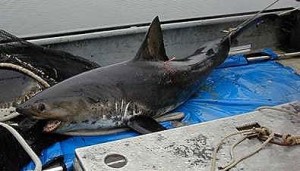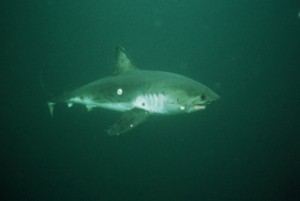
November 2013
Juvenile Salmon Sharks (Lamna ditropis) are known to get stranded, or wash up dead, along the central and southern California coast during late summer and early fall. The reason for this is not fully understood. A recent study examined tissues from 19 stranded sharks, and histopathology revealed meningitis or meningoencephalitis in many of the shark brains, and bacteria (Carnobacterium sp.) in brain and other tissues. It is suggested that the bacterial brain infection is a significant cause of mortality in juvenile Salmon Sharks found stranded along the coast. These strandings are not of great concern due to their sporadic nature, and have not included massive die-offs.
The Salmon Shark is a close relative of the White Shark and Mako Shark; and it is not surprising that the public often confuses the Salmon Shark with its better-known relative, the White Shark. The Salmon Shark is found throughout the North Pacific Ocean, from the surface to 375 meters (and deeper in southern waters). Off our coast it occurs from the Gulf of Alaska to central Baja California.
Salmon sharks are less common than other pelagic sharks off California. There are no records of any attacks on humans.
FACTS
- The Salmon Shark (Lamna ditropis) is related to the White Shark (Carcharodon carcharias); both are in the family Lamnidae
- Salmon Sharks are less common than other pelagic sharks in California
- Maximum reported total length: 305 centimeters (10 feet)
- Maximum age: 20-30 years
- Diet: salmon, Walleye Pollock, Pacific Saury, Pacific Tomcod, lancetfish, herring, mackerel, Pacific Spiny Dogfish, rockfish, and squid
Recent Stranding Events
1999-2010
http://elasmollet.org/Ld/Ld_strandings.html
September 2011
http://www.santacruzsentinel.com/ci_18906558
August 2012
http://www.mercurynews.com/breaking-news/ci_21291835/salmon-sharks-washing-up-central-coast-beaches
August 2013
November 2013
http://blogs.sfweekly.com/thesnitch/2013/11/holy_shit_a_salmon_shark_washe.php
Helpful Links:
Alaska Department of Fish and Game: Salmon Shark Species Profile
http://www.adfg.alaska.gov/index.cfm?adfg=salmonshark.main
Identification characters: Oregon Department of Fish & Wildlife
http://www.dfw.state.or.us/MRP/FishID/images/Lamna_ditropis.jpg
Tagging of Pacific Predators (TOPP): Salmon Shark
http://www.topp.org/species/salmon_shark
Hopkins Marine Station: Salmon Shark
http://hopkins.stanford.edu/profiles/salmonshark.htm
NOAA Fisheries, Alaska Fisheries Science Center
http://www.afsc.noaa.gov/Quarterly/amj2008/amj08.htm
http://www.afsc.noaa.gov/ABL/MESA/mesa_sa_sharks.php
Pacific Shark Research Center, MLML: Life History Data Matrix
http://psrc.mlml.calstate.edu/recommended-reading-list/life-history-data-matrix/
Pelagic Shark Research Foundation: Salmon Shark
http://www.pelagic.org/montereybay/pelagic/salmonshark.html
Additional References:
Ebert, D.A. 2003. The sharks, rays and chimaeras of California. University of California Press, 284 pp.
Schaffer, P.A., B. Lifland, S. Van Sommeran, D.R. Casper, C.R. Davis. 2013. Meningoencephalitis associated with Carnobacterium maltaromaticum–like bacteria in stranded juvenile Salmon Sharks (Lamna ditropis). Vet Pathology 50(3):412-417.
